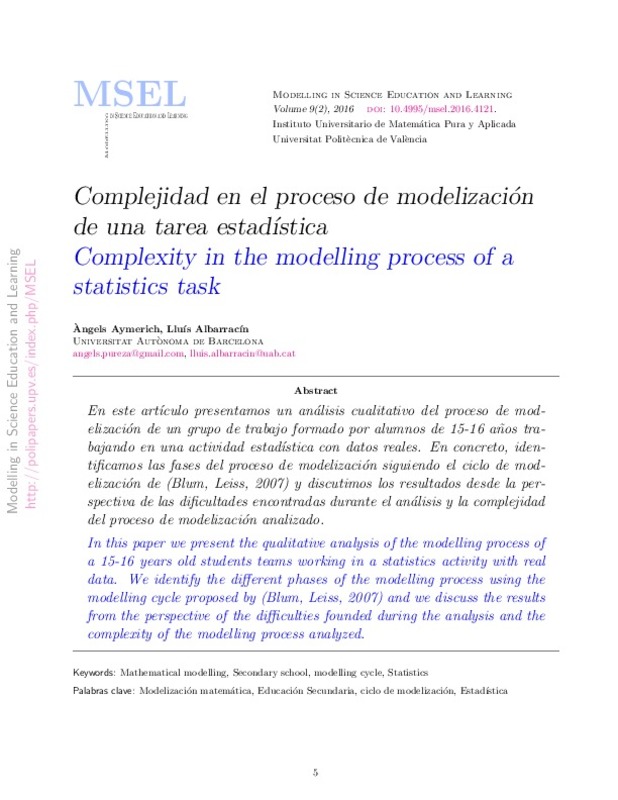Albarracín, L., & Gorgorió, N. (2013). Problemas de estimación de magnitudes no alcanzables: una propuesta de aula a partir de los modelos generados por los alumnos. Modelling in Science Education and Learning, 6, 33. doi:10.4995/msel.2013.1836
Albarracín, L., & Gorgorió, N. (2014). Devising a plan to solve Fermi problems involving large numbers. Educational Studies in Mathematics, 86(1), 79-96. doi:10.1007/s10649-013-9528-9
Arleback, J. B. (2009). On the use of realistic fermi problems for introducing mathematical modelling in school. The Mathematics Enthusiast, 6 (3), 331-364.
[+]
Albarracín, L., & Gorgorió, N. (2013). Problemas de estimación de magnitudes no alcanzables: una propuesta de aula a partir de los modelos generados por los alumnos. Modelling in Science Education and Learning, 6, 33. doi:10.4995/msel.2013.1836
Albarracín, L., & Gorgorió, N. (2014). Devising a plan to solve Fermi problems involving large numbers. Educational Studies in Mathematics, 86(1), 79-96. doi:10.1007/s10649-013-9528-9
Arleback, J. B. (2009). On the use of realistic fermi problems for introducing mathematical modelling in school. The Mathematics Enthusiast, 6 (3), 331-364.
Barbosa, J. C. (2009). Modelagem e modelos matematicos na educac~ao cientca. Alexandria: Revista de Educaçao em Ciencia e Tecnologia, 2 (2), 69-85.
Batanero, C. (2000). Hacia donde va la educación estadística. Blaix, 15 (2), 13.
Blum, W. (2002). Educational Studies in Mathematics, 51(1/2), 149-171. doi:10.1023/a:1022435827400
Blum, W., & LeiB, D. (2007). Mathematical modelling (ictma 12): Education, engineering and economics. In W. B. S. K. C. Haines P. L. Galbraith (Ed.), (pp. 222-231). Elsevier.
Ferri, R. B. (2006). Theoretical and empirical differentiations of phases in the modelling process. ZDM, 38(2), 86-95. doi:10.1007/bf02655883
Gal, I. (2002). Adults’ Statistical Literacy: Meanings, Components, Responsibilities. International Statistical Review, 70(1), 1-25. doi:10.1111/j.1751-5823.2002.tb00336.x
Geiger, V. (2011). Factors Affecting Teachers’ Adoption of Innovative Practices with Technology and Mathematical Modelling. Trends in Teaching and Learning of Mathematical Modelling, 305-314. doi:10.1007/978-94-007-0910-2_31
Lesh, R. (2010). Tools, researchable issues & conjectures for investigating what it means to understand statistics (or other topics) meaningfully. Journal of Mathematical Modelling and Application, 1 (2), 16-48.
Lesh, R., & Harel, G. (2003). Problem Solving, Modeling, and Local Conceptual Development. Mathematical Thinking and Learning, 5(2-3), 157-189. doi:10.1080/10986065.2003.9679998
Levitt, S. D., & Dubner, S. J. (2005). Freakonomics: A rogue economist explores the hidden side of everything (Vol. 61). William Morrow.
NCTM. (2003). Principios y estandares para la educacion matematicas. Sevilla: SAEM Thales.
Palm, T. (2007). Impact of authenticity on sense making in word problem solving. Educational Studies in Mathematics, 67(1), 37-58. doi:10.1007/s10649-007-9083-3
Perrenet, J., & Zwaneveld, B. (2012). The many faces of the mathematical modeling cycle. Journal of Mathematical Modelling and Application, 1 (6), 3-21.
Pollak, H. O. (1979). The interaction between mathematics and other school subjects. New Trends in Mathematics Teaching IV, Paris.
Sol, M., Giménez, J., & Rosich, N. (2011). Trayectorias modelizadoras en la ESO. Modelling in Science Education and Learning, 4, 329. doi:10.4995/msel.2011.3100
Villa-Ochoa, J., Bustamante, C., & Berrio, M. (2010). Sentido de realidad en la modelacion matematica. ALME 23. Comite Latinoamericano de Matematica Educativa-Colegio Mexicano de Matematica Educativa.
Vorhölter, K., Kaiser, G., & Borromeo Ferri, R. (2014). Modelling in Mathematics Classroom Instruction: An Innovative Approach for Transforming Mathematics Education. Advances in Mathematics Education, 21-36. doi:10.1007/978-3-319-04993-9_3
[-]









